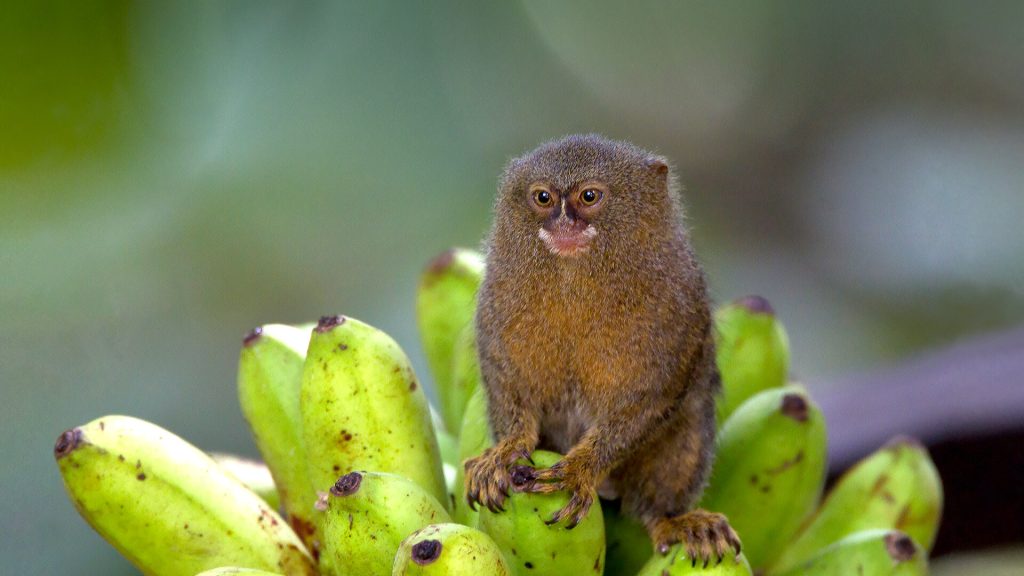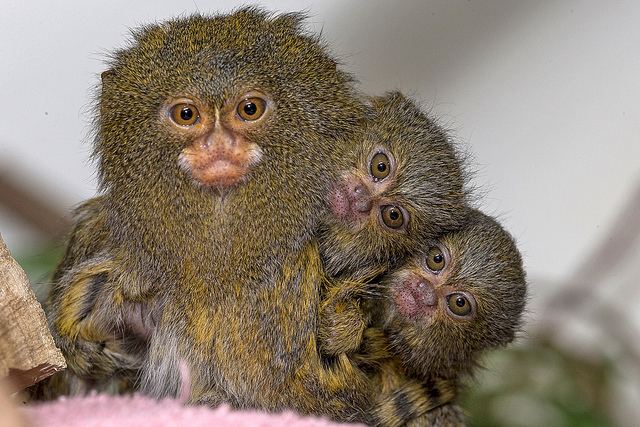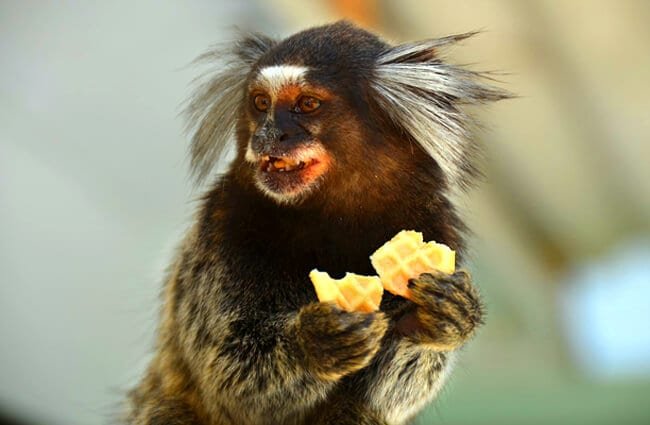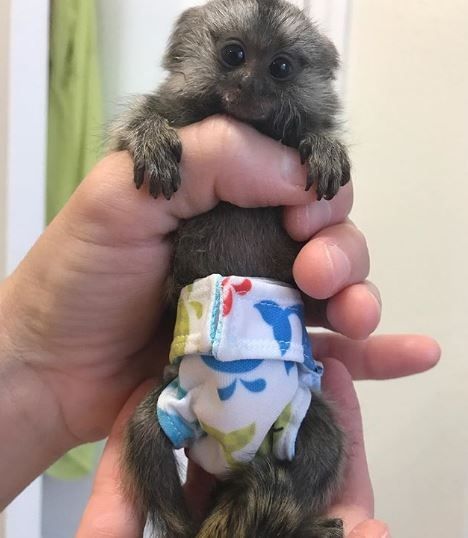Without a doubt, small objects always attract the most attention. And what if these adorable little creatures were real live creatures? It seems difficult to think of an animal that small. We are discussing Marmosets (Callithrix /Cebuella), the smallest species of monkey in the world.
Because of their small size (the size of a finger) at birth, some people refer to them as “finger monkeys”; this is not a scientific term. Although there is a catch, these smaller New World monkeys are known as callitrichids. The phrase “finger monkey” is incredibly inaccurate.
Pet Marmoset monkeys need specific care and should be treated like small kids. This guide covers all you need to know about keeping a marmoset monkey as a domestic pet, from special diets to cage specifications.
scientific classification of the pygmy marmoset
| Kingdom | Animalia |
|---|---|
| Phylum | Chordata |
| Class | Mammalia |
| Order | Primates |
| Family | Callitrichidae |
| Genus | Cebuella |
| Species | C. pygmaea |
Do Marmoset Monkeys Make Good Pets?
Pygmy marmosets are also referred to as pocket monkeys, finger monkeys, or both. They are the smallest species of monkey and one of the tiniest primates still living. It is an absurdly small primate that resembles the toy of the same name and can literally cling to a human finger. Do these cute tiny creatures actually exist, and if so, would they make good pets?
In regards to the first question, “finger monkeys” are in fact actual animals. Although there is a catch, these smaller New World monkeys are known as callitrichids. The phrase “finger monkey” is totally misleading.
While there are little monkeys, like the pygmy marmoset, the tiniest species of monkey species have been identified, the smaller monkeys sold as pets in the West are the bigger marmoset and tamarin species, which when they grow to adult size do not fit on a human finger.
Showing these animals clinging to people’s fingers seems to be a marketing trick used by some sellers to build interest in the small monkeys and perhaps make them seem more like desirable pets. This is unfortunate because primates in general make difficult pets for regular pet owners.
Pygmy marmoset legal issues: Is It Legal to own as a pet?
A good place to start is here. Pygmy marmosets must first be legally permitted for ownership before we can discuss how to care for them.
The answer to that can be yes or no, depending on where you live.
Here is a list of states where owning a finger monkey is (or presumably maybe legal:
No licenses are required in Alabama, Nevada, Kansas, Montana, North Dakota, Nebraska, Iowa, Arkansas, Illinois, Wisconsin, Missouri, Ohio, West Virginia, and Virginia as of the writing of this article. But make sure twice before you buy! Laws frequently change.
To pet any kind of primate wild or other potentially dangerous animals, special permissions are needed in Oklahoma, Pennsylvania, Rhode Island, Arizona, Indiana, Mississippi, and Tennessee. Contact the state Department of Agriculture to request your license. Please take note that applying for a mission does not ensure you will be given one. Additionally, a lot of these states only have temporary bans; thus, you may run into problems with the law even before submitting an application.
Does either of these listings include your state? The first challenge has been overcome if so. You should be aware that you might still require formal permits and licenses to keep a primate. Some states transfer authority to a specific county or municipal authority. North Carolina is a state without a nationwide ban, but one where choices are determined at the county level.
No matter the situation or the number of appeals you file, many states have enacted blanket prohibitions on primates. In these states, only individuals who operate sanctuaries or educational animal exhibits are authorized to maintain primates (or any other kind of wild animal).
Even then, many requirements must be fulfilled. These include Minnesota, New York, New Jersey, California, Colorado, Connecticut, Georgia, Kentucky, Louisiana, Maine, Maryland, Massachusetts, New Hampshire, and New Mexico. Decide to settle for a cat if you reside in one of these states.
Pygmy Marmoset Habitat & Behavior
Pygmy Marmoset – Life In The Wild

Being social animals, finger monkeys love to move around and live in groups. Turf battles are ferocious and well-known for being extremely territorial.
Pygmy marmoset monkey groups typically consist of seven to eight individuals, with an even number of males and females. If you wish to keep pygmy marmosets as pets, it is much preferable for them and for you to have at least two because they love to live in a group.
Pygmy marmosets enjoy company, are intelligent enough to communicate, and can even interact with other monkeys by employing a variety of speech patterns, such as chirps and squeaks.
When someone in the group notices an ocelot, the others are warned and instructed to take cover in the trees. The cautious finger monkeys prefer to remain with their group, even when they are hidden in the woods.
It is important to know before keeping them as pets that they are easily agitated and annoyed and very sensitive to human viruses like the flu. Due to their intelligence, playfulness, and potential for misbehavior, most veterinarians frequently compare finger monkeys to toddlers.
Most of the time, these monkeys fight, squeak loudly and even throw poo at one another. They can bite, scratch, and attack you since they have a very bad temper.
While these monkeys are complex animals, adopting them into your family is still possible. Although their charming looks give the impression that they would make wonderful pets, they are actually more difficult to manage than you may imagine.
Habitat

The pygmies are frequently found in Ecuador, Brazil, and Columbia, like tropical climes that are hot and rainy all year round. Specifically, the Amazon Rainforest.
They can climb to the nearby branches of other trees because they and their families live on tall trees. To avoid being seen by their predators, they also weave through trees. They can blend in better with dark branches and tree trunks because of their brown fur.
Reproduction & Breeding Process
Similar to other animals, these small primates frequently reproduce. In actuality, the breeding season for finger primates lasts all year long. However, their breeding procedure involves a few specific circumstances.
For instance, a male monkey that is ready to reproduce will identify a specific location with his scent gland while looking for a mate and then follow one female monkey.
A pair of finger monkeys—a male and a female—can live harmoniously and reproduce for the duration of their lives. Additionally, they reproduce as a troop while the other group members assist in taking care of their youngster.
Between 119 and 140 days are required for delivery. The female finger monkey gives birth to twins roughly twice a year, according to the majority of research. Triplets are 8% likely to be born, while a single monkey is 16% likely to do so.
Food Habit

As natural hunters, finger monkeys can be seen pursuing small insects, moths, spiders, and beetles. Since they are omnivores, they enjoy eating fruits, nectar, and insects.
A finger monkey’s main food source, despite the fact that they hunt, is tree sap. Sharp teeth on the marmosets allow them to dig holes and remove the bark from trees.
The monkeys repeatedly scrape into the bark until they come across the sap, and when they do, they consume it in many ways. Cats do water from bowls. When their claws fail, they have unique incisors that can cut through vines, branches, and tree trunks. Finger monkeys also eat tree vines, resin, and gum.
They dig holes in trees using their razor-sharp teeth to get at the gum. In the wild, they devote one-third of their time doing this. It is a source of energy, calcium, and other nutrients in addition to the fact that “it will keep them busy for a long.” It is well known that other animals, like squirrels and tamarins, also enjoy Arabic gum.
Due to their small size, finger monkeys do not require large amounts of food to survive. They search for food in the morning. At a time, they only eat one tablespoon of tree sap.
In zoos, finger monkeys are fed a diet consisting of a combination of simple fruits and vegetables to digest. They cannot take processed food because it could hurt them; thus, close monitoring of the quantity and type of meal is necessary.
How to Take Care of a Pet Marmoset?
Home Environment

Primates of all species, regardless of size, provide a special challenge to keep healthy and content in captivity.
Marmosets are wild animals with highly specific needs. An habitat as complex as that found in the wild cannot be created. Specialized nutrition and outdoor access (UV light). are needed to prevent common health problems like bone disease. They are not domesticated in the same way that cats and dogs are.
Your marmoset can live in a medium- to large-sized cage as long as they have plenty of opportunity for movement outside the cage. When it comes to cage size, the bigger, the better. They do really require an enclosure! Regardless of how much time is spent outside the cage. For their protection or any other reason, you have to be able to keep your marmoset in their own area.
Marmosets are required to sleep within their cage! They should not sleep with their owners since it is unsafe.
If kept in a small cage all day with little to no interaction, they will get bored and miserable. It is imperative to give them access to a play area or a tall outdoor cage where they can climb to great heights much like they would in the wild.
Social Requirement
Monkeys and other primates are relatively sophisticated in their social relationships and cognitive abilities, as one might expect given their close kinship to humans. While all pet mammals require some level of stimulation, monkeys are quick-witted, will get bored with the toys their owner gives them more quickly and may be highly time-demanding, much like many parrot species.
One of the main problems with keeping a monkey as a pet is that they require social enrichment unless their human owner is present with them at least 90% of the time, which is unlikely for the majority of people.
Most likely, all monkeys should live with at least one other member of their own species. When they are imprinted on people, many primate species are also known for turning territorial and hostile, and some even viciously attack outsiders!
Pet marmoset maintenance costs
Financial Cost:
- Canned Marmoset Food- $3-$5 /Month
- Cage- $100-$400
- Swings and Hammocks- $30-$50
- Whole foods and dietary supplements- $20-$30/Month
- Diaper and covers- $20-$30/Month
- Clothes- $5-$20
- Toys- $5-$10
NOTE: They are tropical animals; therefore they need 24-hour heating is required; Also, specialized veterinarian costs and other medical costs will be included.
Time Cost: Monitoring closely, giving enhancement tasks and activities, training, preparing food, cleaning pens, etc.
Potty Train Your Pet Monkey
Not all monkeys can be taught to use a toilet or their cage. You might need to leave padding outside or put your monkey in a special outdoor habitat that needs to be cleaned frequently.
Refrain from always keeping your monkey in diapers. This is inhumane and might lead to rashes.
There is a good chance that you’ll be able at least encourage your monkey to use a particular specified area of the enclosure if you keep him or her in a larger enclosure or outside area. The food and water bowls can be strategically placed to achieve this.
Never neglect to regularly clean this space. If your monkey doesn’t have a spot that is just for them, they can wind up going on other stuff.
Watch out since some monkey species, like some New World tree-dwellers, might not even want to learn how to behave thus carefully.
How To Diaper a Monkey

The tail hole method is the most well-known diapering technique among owners of primates, although an increasing number of them are converting to the tail wrap technique.
The majority of those who use the tail hole method don’t appear to have tried the tail wrap method. Those who have say that the tail hole approach is quicker to use, less noticeable when a diaper cover or other clothing is worn, and more comfortable, especially with smaller monkeys.
The tail wrap method is more popular since it leaves a pouch so that the poop doesn’t stick, eliminates the possibility of leakage around the tail (which can occur with the tail hole approach), and because the air pocket lessens the likelihood of skin irritation from moisture. Additionally, since you are not cutting the diaper as you would with the tail-hole approach, no jelly, beads, or filling can fall out of the diaper, depending on the brand you use.
Living with a Pet Marmoset

Marmosets can be fun and pleasant pets for the proper home if they are raised by hand from infancy. Even as infants, they have the loveliest looks and the biggest personality. After you have trained them, leaving them unsupervised in the house throughout the day is a very good option, provided your home has been marmie-proofed. They’ll act ridiculous to get your attention and ensure you’re paying attention.
One of the tiniest monkey species is the marmoset, a member of the primate family. Some people will use specialized monkey diapers since their urine has a strong odor. To transmit scent, they rub their perineum over everything in their living quarters, including toys, food dishes, blankets, plush animals, furniture, rugs, and caging.
They require excitement because they are intelligent. Toys can enhance interaction, but if a marmoset is maintained as a pet by itself, it will depend on the human family to serve as its family unit.
A marmoset is NOT FOR YOU if no one will be home throughout the day or if you have young children.
One cannot expect monkeys to act “properly” like humans.
Monkeys are only content when their social and emotional requirements are met. They require other social animals that are similar to themselves, a sense of love and security, and often yearn for sincere affection. To imagine them as cats, dogs, or hamsters is incorrect.
Monkeys are highly intelligent, have complex emotional needs, and have a tendency for long life.
They must always have a qualified veterinarian on call in case of the disease since veterinary care is highly vital. NOT an animal to be purchased on an impulse. For any primates, the screening process is important.
They need a lot of care and attention and cannot be left in a cage by themselves for long periods of time. A marmoset is NOT FOR YOU if no one will be home throughout the day or if you have young children.
Additionally, they are susceptible to human illnesses like the flu, chicken pox, and HIV. Get a guarantee that your monkey is healthy from the breeder. Check out if a veterinarian in your area specializes in primates before opting to bring one home.
Cold sores, the flu, and viruses can potentially be lethal for baby marmosets. For this reason, you shouldn’t take them out in public or expose them to a lot of people.
When they become sexually mature, they experience significant transformation. Usually, only connect with the one or two people who gave them care as infants. They become aggressive or hostile toward strangers or children and do not get along well with them. Despite their diminutive size, they have sharp teeth that are capable of serious harm.
Things To Keep In Mind Before Getting A Marmoset
Marmosets will hang on the side of the cage and urinate outside of it, even though they don’t throw their poop. Marmoset urine SMELLS.
A pet marmoset can quickly pick up human illnesses like the common cold. When a marmoset licks a plate or spoon that was previously used by a person or came in close contact with the owner, the virus from that person may be passed on to the marmoset.
Around the most dominant individual, captive marmosets grow possessive and may attack and bite other people.
Some marmosets can be incredibly vicious and hostile when they become sexually active. Since marmosets are such highly gregarious creatures, they must never be kept alone.
They need specialized marmoset foods, which can only be obtained at specialty shops or ordered online.
Hugues Beaufrere is the Exoticpetia’s senior writer and reptile expert. He has been fascinated by reptiles and monkeys since he was a kid and had years of experience in herpetology and primatology. He has cared for various kinds of Monkeys, Lizards and Reptiles and loves to share his knowledge and passion with others.



Hey what are the distinctive behavioral traits of Pygmy Marmosets, especially in terms of their social interactions and communication within a group?
Why do Pygmy Marmosets hang on the side of their cages, and what do they do that might be a little funny?
I am thinking of getting a pair of these monkeys.
Wоw, this post iѕ nice, my sister is analyzing these things, thus Ι am going to tell her.